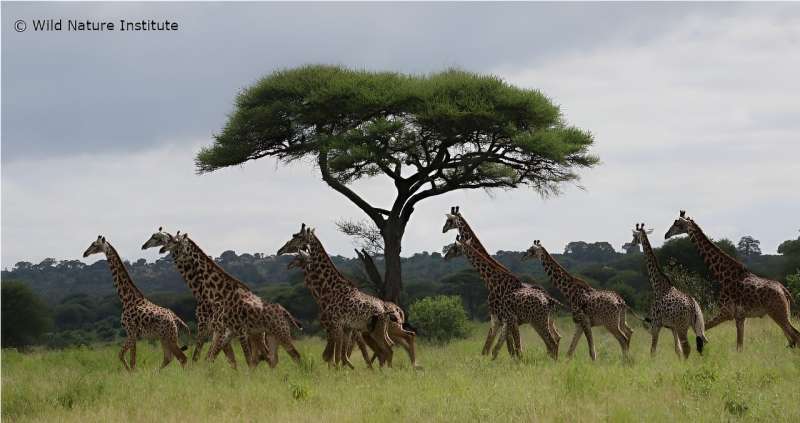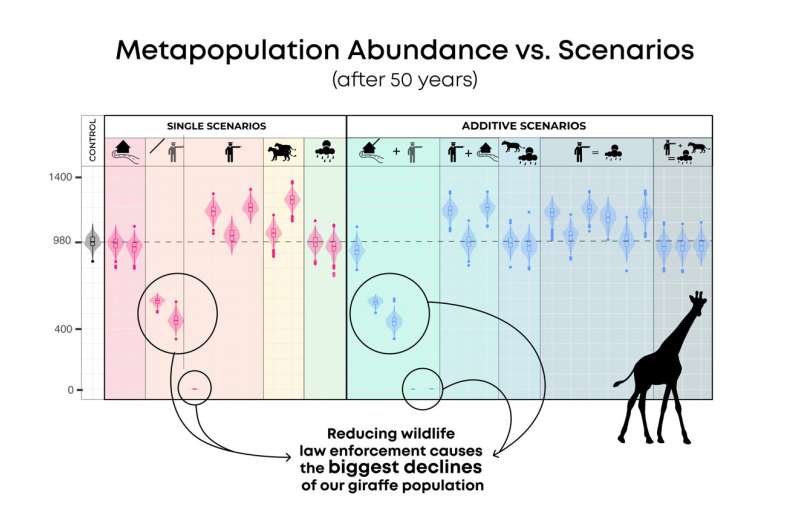This article has been reviewed according to Science X's editorial process and policies. Editors have highlighted the following attributes while ensuring the content's credibility:
fact-checked
peer-reviewed publication
trusted source
proofread
Study shows the best way to save giraffes is to support wildlife law enforcement and end poaching

Iconic animals such as giraffes can be flagship species for conservation because of their charisma and popularity among the public. A new study explored the various threats to giraffe populations, and how specific human actions can mediate those threats so that giraffes and people can thrive together in African savannas.
The giraffe is an icon of the African savannas, instantly recognizable with its unique shape and height and dazzling spot patterns. Yet despite the popularity of giraffes around the world, they face major challenges to their continued surviving in the wild. Numbers of giraffes and other large, charismatic animals such as elephants and rhinos have plummeted, and giraffes are now listed as an endangered species.
In research published today in the journal Global Change Biology, scientists from the Doñana Biological Station, Penn State University, and Wild Nature Institute showed that effective wildlife law enforcement which protects giraffes from illegal hunting is the best way to keep giraffe populations healthy and thriving.
Giraffes are physically large, so they require a lot of space to move around. They live a long time, nearly 30 years, and are slow to breed, with giraffe mothers first giving birth at the age of 6 and producing only one calf about every 2 years thereafter. Giraffes are increasingly in danger from one of the most cunning predators of all: people. Giraffes are killed by poachers working for criminal syndicates to sell their meat and body parts in bushmeat markets.
Giraffes are also losing their natural savanna habitat to farms and urban sprawl, and climate change is increasing heavy rainfall events which spread diseases that cause giraffe deaths. To conserve giraffes we need to know which natural- and human-caused pressures are most important in driving their population declines, and whether human actions could mediate the threats.

In this study the scientists aimed to understand how changes in land use, illegal hunting, and rainfall affected the abundance of Masai giraffes in the human-impacted Tarangire region of Tanzania in East Africa. This region hosts two world-class national parks, an ecotourism livestock ranch, and village lands, all with different levels of land and wildlife conservation.
The scientists have monitored giraffes in the area for nearly a decade to learn how each of these threats influences giraffe survival. The researchers then combined the information they learned from previous studies to create an individual-based model that simulated realistic population dynamics and extinction risk under different scenarios of environmental change over 50 years.
They tested a set of credible threats to the persistence of giraffes in this system, including an expansion of towns along the edges of the study area, loss of connectivity between key habitat areas, improved or reduced wildlife law enforcement, changes in predation pressure on giraffe calves from changes in lion and wildebeest populations, and more heavy rainfall events as predicted for East African savannas. They also tested combinations of scenarios, as well as management actions that could mitigate the threats.
The study showed that the greatest risk of population declines and extinction for giraffes is caused by a reduction in wildlife law enforcement leading to more poaching. Furthermore, an increase in law enforcement would mitigate the effects of the most extreme predicted increases in heavy rainfall and the expansion of towns. The study highlights the great utility of law enforcement as a nature conservation tool.
The scientists' research demonstrated that giraffes benefit from the presence of traditional livestock herders on the rangelands outside parks that are shared by giraffes and pastoralists. The problems arise when giraffe rangeland habitat is plowed into farms, when towns and other development sprawl into the habitat and force giraffes to move longer distances to find food and water, and when people kill giraffes for bushmeat markets.
The scientists recommend that wildlife law enforcement be expanded in village lands outside of protected areas, legal livelihoods be promoted to reduce the perceived need for poaching for income, and wildlife movement pathways be permanently protected from farming, mining, and infrastructure to enable giraffes and migratory wildebeest to access high-quality habitats.
These measures would increase the population of giraffes in the Tarangire region and contribute to the recovery of this endangered species, while ensuring people and giraffes thrive together.
More information: Bond ML, et al, Extinction risks and mitigation for a megaherbivore, the giraffe, in a human-influenced landscape under climate change, Global Change Biology (2023). DOI: 10.1111/gcb.16970. onlinelibrary.wiley.com/doi/10.1111/gcb.16970
Journal information: Global Change Biology
Provided by Wild Nature Institute


















